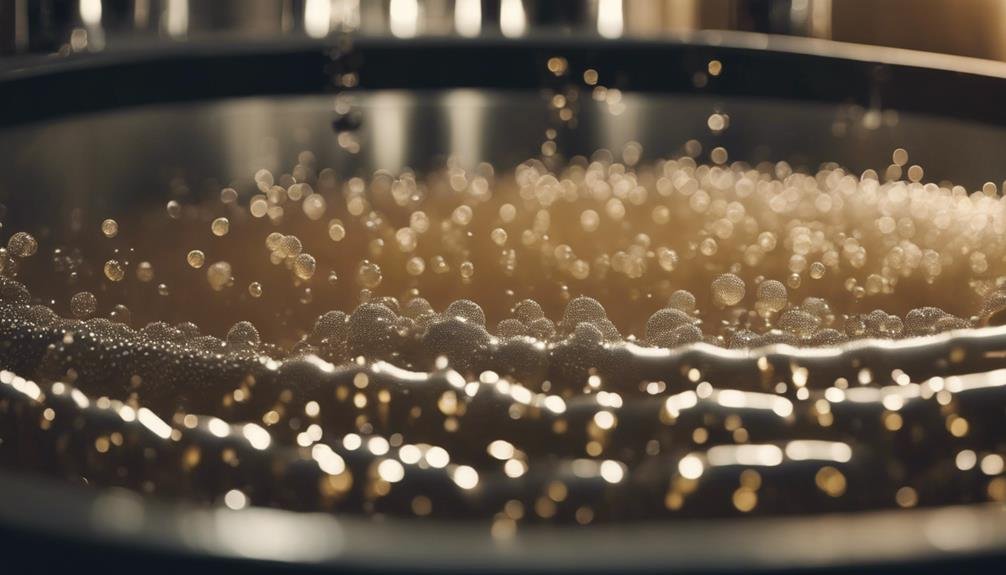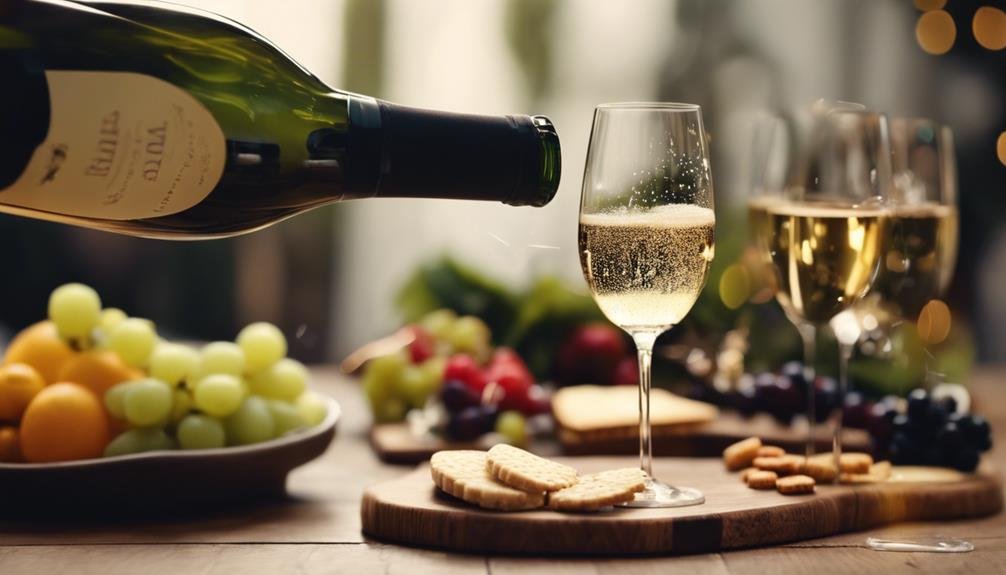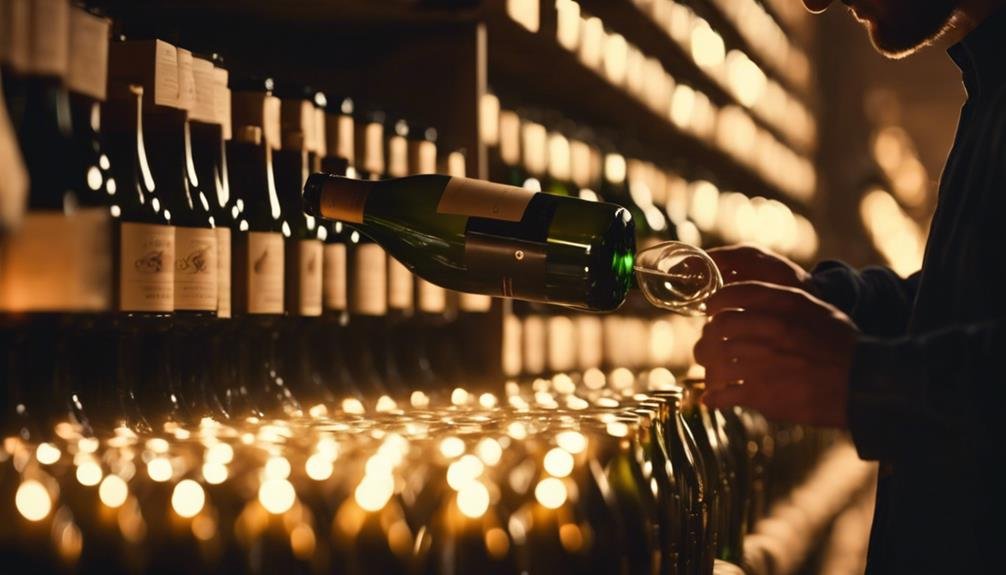Explore the intricate world of sparkling wine production methods, uncovering meticulous techniques behind crafting these effervescent delights. Aging methods enhance flavor complexity, while bottle fermentation adds depth and fizz. Quality indicators like aging on lees guarantee superior results. Traditional, tank, transfer, ancestral, and carbonation methods each offer unique characteristics to sparkling wines. From cuvée blending to second fermentation, the process is vital for quality. Discover the nuances of wine tasting components to appreciate fruity, floral, spicy, or earthy notes. Uncover the secrets behind sparkling wine production for a deeper understanding of these bubbly treasures.
Production Methods Overview
In the world of winemaking, understanding the intricacies of various production methods is essential for producing sparkling wines of exceptional quality. Aging techniques play a pivotal role in developing complex flavor profiles that distinguish sparkling wines.
Bottle fermentation, a hallmark of traditional methods, adds depth and effervescence to the final product. Quality indicators, such as the duration of aging on lees and the meticulous process of riddling and disgorging, guarantee a superior end result. These methods contribute to the unique characteristics of sparkling wines, offering a spectrum of aromas, textures, and tastes that delight the palate.
Traditional Method Details
The foundational technique behind crafting exquisite sparkling wines lies in the meticulous execution of the Traditional Method. This method involves the fermentation of base wine and its subsequent blending into a cuvée for the second fermentation, which adds CO2 and alcohol. To provide a clearer picture, let's explore the details:
| Traditional Method Details | |
|---|---|
| Base Wine Fermentation | Fermentation of base wine. |
| Cuvée Blending | Blending of base wine into cuvée. |
| Second Fermentation | Addition of CO2 and alcohol. |
Tank Method Explained

Utilizing a specialized technique in sparkling wine production, the Tank Method involves conducting the second fermentation of base wines in a pressurized tank. This modern technique enhances efficiency by allowing for the production of sparkling wines without the need for extended aging.
The benefits of the Tank Method include the preservation of fruit-forward flavors and the creation of wines with a freshly made character. By filtering, dosing, and bottling the wines directly after fermentation, producers can achieve a quicker turnaround time and maintain the wine's vibrant qualities.
Commonly used in the production of Prosecco and Lambrusco, the Tank Method showcases how innovative approaches in winemaking can result in high-quality sparkling wines with distinct characteristics.
Transfer Method Breakdown
A detailed examination of the Transfer Method in sparkling wine production reveals its unique process of sending wines through filters before bottling. This method involves an essential filtering process that guarantees the wine's clarity and purity before it is bottled.
Unlike the Traditional Method, where wines age on lees in the bottle, the Transfer Method allows for the removal of sediment and impurities through filtration. Additionally, the use of pressurized fillers during the bottling process helps maintain the wine's effervescence and quality.
The Transfer Method is particularly useful for non-standard bottle sizes, offering a practical solution for sparkling wine producers looking to achieve consistency and excellence in their products.
Ancestral Method Unveiled

Exploring the unique methodology of the Ancestral Method sheds light on a distinct approach to sparkling wine production that diverges from traditional techniques. Within this method, the fermentation process is paused midway, and CO2 is trapped in the bottle to finish fermentation naturally. Unlike other sparkling wine methods, no expedition liqueur is added, resulting in a pure expression of the wine's characteristics. Variations such as the Méthode Diose Ancestrale may involve filtering the wines in pressurized tanks for clarity and refinement. When it comes to closure options for Pétillant Naturel wines produced using the Ancestral Method, crown caps are commonly used for their convenience and ability to preserve the wine's effervescence effectively.
| Méthode Diose Ancestrale Variations | Closure Options for Pétillant Naturel |
|---|---|
| Filtering in Pressurized Tanks | Crown Caps |
Carbonation Method Insights
The Carbonation Method involves the carbonation of still wine in a pressurized tank, a technique commonly employed for lower quality bulk wines. This method is often utilized for its cost-effectiveness, allowing for the production of sparkling wines at a faster pace compared to traditional methods.
However, there is an ongoing quality debate surrounding wines produced using the carbonation method. Some argue that the process can result in a loss of complexity and depth in the final product, leading to questions about the overall quality of wines made through this method.
While it offers efficiency in producing bulk quantities of sparkling wine, the trade-off between speed and quality remains a topic of discussion within the wine industry.
Key Wine Tasting Components

Moving from the discussion on the carbonation method in wine production, an examination of the key wine tasting components sheds light on the fundamental aspects that define a wine's sensory experience.
Aroma exploration plays an important role in wine tasting, revealing the intricate bouquet of scents that the wine offers. It allows enthusiasts to appreciate the complex mix of fruity, floral, spicy, or earthy notes present in the wine.
Moreover, finish comparison focuses on the aftertaste left once the wine is swallowed. Whether it is short and crisp or long and lingering, the finish provides valuable insights into the wine's quality and complexity.
Understanding these key components enhances the overall wine tasting experience and helps individuals develop a more profound appreciation for different wine varieties.
Frequently Asked Questions
What Are the Key Differences Between Champagne and Prosecco Production Methods?
Champagne and Prosecco production methods differ in several key aspects. Champagne undergoes longer aging processes, resulting in complex flavors, while Prosecco utilizes tank fermentation for a fresher profile. Champagne uses traditional methods, while Prosecco employs the tank method, influencing carbonation levels.
How Does the Price of Sparkling Wine Correlate With the Production Method Used?
The connection between sparkling wine prices and production methods is vital. Consumer preferences, market trends, and perceived quality greatly influence pricing. Understanding how production methods impact cost allows consumers to make informed decisions based on their preferences and budget constraints.
Are There Any Environmental Sustainability Considerations in Sparkling Wine Production?
In the domain of sparkling wine production, environmental impact is an important consideration. Sustainable practices, such as organic viticulture, energy-efficient processes, and water conservation, play a significant role in minimizing the industry's ecological footprint.
Can Sparkling Wine Be Made Using a Combination of Different Production Methods?
Sparkling wine can indeed be crafted using a combination of different production methods. Blending techniques and alternative methods offer winemakers flexibility to create unique sparkling wines with diverse characteristics, showcasing the artistry and innovation in winemaking.
What Role Does Yeast Play in the Production of Sparkling Wine?
Yeast fermentation is essential in sparkling wine production, playing a pivotal role in creating carbonation. By consuming sugars, yeast produces alcohol and carbon dioxide, leading to the effervescence characteristic of sparkling wines. Various carbonation techniques enhance the final product.
Conclusion
In the domain of sparkling wine production, tradition intertwines with innovation, creating a symphony of flavors and aromas that captivate the senses.
From the meticulous Traditional Method to the modern Tank, Transfer, Ancestral, and Carbonation methods, each approach adds its unique essence to the effervescent elixir we savor.
As we unravel the secrets behind the bubbles, finesse in fermentation, and expertise that culminate in sparkling excellence, we invite you to immerse yourself in the magic of this exquisite craft.
